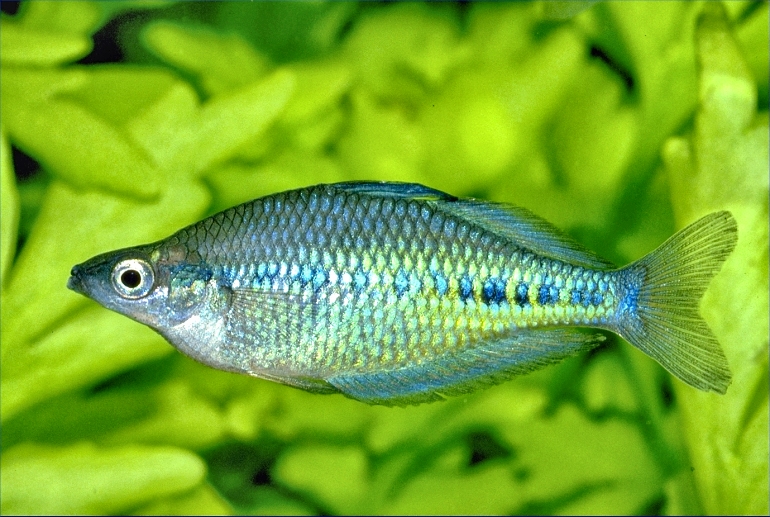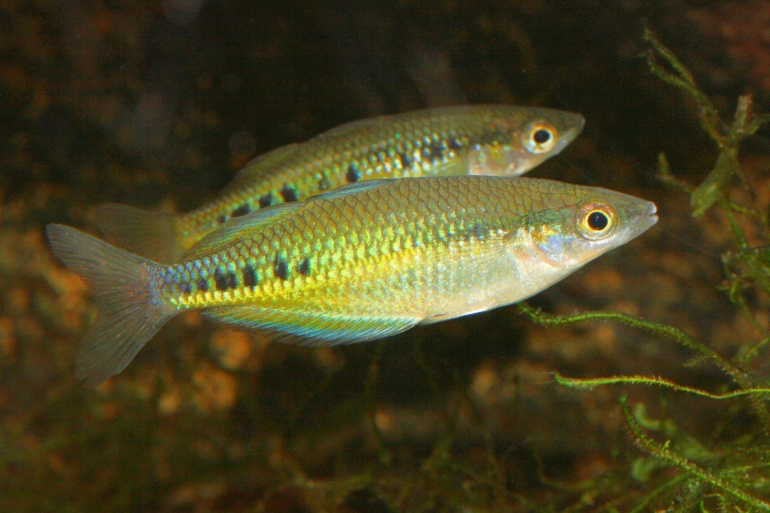|
 |
Glossolepis maculosus - photo© Neil Armstrong |
Allen, 1981
Spotted Rainbowfish
Species Summary
Glossolepis maculosus males have an overall body colour of greenish-bronze with faint pale-blue reflective scales and a series of dark spots or blotches along the lateral line. These may number from 4 to 10 but can vary considerably. Each individual has its own pattern of distinctive spots along the sides. Even the left and right sides of each individual can be differently marked. Below the lateral line the body colour is whitish anteriorly and yellowish posteriorly. Fins are bluey-green with a slight hint of orange and black margins. The colouration of the female is drab compared to the male, but they still show distinct spots, but otherwise are pale olive with a silvery belly. Mature, older females often show colouration similar to subordinate males, but are usually easily identified by a shallower body/chest depth and smaller, more rounded fin edges. Mature males are usually much larger and deeper bodied than females and have a higher first dorsal fin, which overlaps the origin of the second dorsal fin when depressed. Glossolepis maculosus may reach a maximum size of 8 cm, but usually less than 6 cm.
Recent genetic evidence suggests this species should be placed in the genus Melanotaenia rather than Glossolepis.
 |
Glossolepis maculosus (male+female) - photo© Dirk Godlinski |
Distribution & Habitat
Glossolepis maculosus are so far only known from a few localities in the Markham, Ramu and Sepik river systems of northern Papua New Guinea. Initially discovered and collected by Barry Crockford during 1979, in a small tributary of the Oomsis River about 22 km west of Lae, Papua New Guinea. He collected a small number of live specimens and returned to Australia. He later sent a coloured drawing of the fish to Gerry Allen at the Western Australian Museum in Perth who confirmed that he had collected a new species of rainbowfish. A year later Gerry Allen returned to this location with Barry and collected several more live fish, which were later bred and distributed in the Australian hobby. Some years later Heiko Bleher collected a small number of live specimens from the Ramu River valley and introduced them to the European hobby. They have been found cohabiting with Glossolepis kabia, Melanotaenia affinis, and Chilatherina campsi.
Glossolepis maculosus are a stream dwelling species and inhabit slow-flowing streams, swamps, and quiet backwaters. Occurs most frequently in relatively still, clear water, in water temperatures between 18-28° Celsius. Water conditions recorded at one collecting site were temperature 25° Celsius, pH 7.8 and hardness 80 ppm. They are usually found along grassy banks, or around sub-surface vegetation, submerged logs, and branches.
Remarks
Glossolepis maculosus have never been widely available and even today could still be considered uncommon. Only a handful of enthusiasts are maintaining them in captivity. Due to the small number of founding stock collected, the colouration of specimens in captivity has changed over the years. Nevertheless, they are still a very attractive species and if someone is willing to spend some time with them, they could end up with a beautiful aquarium fish.
Literature
Allen G.R. (1981) A new species of Glossolepis (Pisces: Melanotaeniidae) from fresh waters of Papua New Guinea. Records of the Western Australian Museum 9(3): 301-306.
Crockford B. (1985) Glossolepis maculosus. Fishes of Sahul 3(1): 102-104.
Adrian R. Tappin
Updated August, 2016



|

